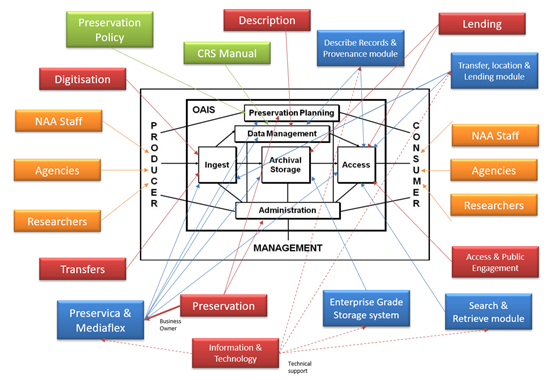Carey Garvie is Project Officer, Digital Archives Innovation and Research at the National Archives of Australia
After a hectic September of virtual conferences and opportunities to connect and share stories about how the National Archives of Australia does digital preservation with the broader community, I finally got a chance to sit back and start writing our blog for World Digital Preservation Day 2021 (WDPD2021). Reflecting on the theme of ‘Breaking Down Barriers’ and making digital preservation ‘understandable, relatable and accessible to all’, I began to think not about external community activities but internal ones instead.
Way back in 2015, the National Archives launched the Digital Continuity 2020 policy, requiring all Commonwealth Government agencies to move to digital recordkeeping by 2020. (We launched the follow-up policy, Building Trust in the Public Record, at the start of this year.) As the policy maker in this area, and as a Commonwealth Government agency itself, the National Archives was also bound by Digital Continuity 2020. More than that, though, we also needed to ensure agencies were supported in their transition to digital recordkeeping, and to prepare for the eventual increase in transfers of digital records.
While National Archives has been actively receiving transfers of digital records from agencies for some time, digital archiving had originally been carried out by a dedicated unit. However, aligning with a ‘digital first’ vision, the ‘doing’ of digital archiving is now incorporated into the day-to-day work of the teams responsible for description, transfer, preservation and access. The challenge was to break down the barriers around digital preservation that had previously been seen as a niche section or skillset, and make it understandable, relatable and accessible to all of our staff.
Part of our response to this challenge was the development of a 3-year Digital Archiving Capability Strategy, following an assessment of gaps in staff skills. This included developing 4 learning modules: Digital Archiving, Digital Preservation, Digital Formats and Metadata. Short versions of these are available online as part of our e-learning suite, and longer, face-to-face workshops were developed for delivery at our National Office in Canberra. Then COVID hit.
Rather than fall into despair, we saw this as an opportunity to go fully digital, and transitioned to delivering the longer workshops online. As a member of the National Archives’ Digital Archives Innovation and Research team, I’ve been testing pilot versions with staff around the country, who have been working, on and off, from home for the past year, and refining the experience as we go. There is nothing like having a captive audience willing to do anything for a break from data entry!
Seriously though, a big challenge is getting people to engage with a topic that, for many, does not yet directly impact their day-to-day work. With a large physical collection there is still a huge volume of material to manage, describe and provide access to, and embedding digital archiving is still a work-in-progress.
Noting that engagement with the Digital Preservation and Digital Archiving e-learning modules was relatively low compared to metadata and formats, we decided to tackle these first. Moving to online meant that several activities had to be reworked. This provided an opportunity to see how we could develop tasks that help break down barriers (there’s the WDPD2021 theme!) and let staff see how digital preservation and archiving concepts relate directly to their work. Some of the activities we came up with were:
DPC RAM: staff are asked to highlight where they think their section sits against each capability and discuss with staff from other teams to see if they might change their opinion. This way they gain an insight into the full spectrum of digital archiving activities and how it is shared across the National Archives.
DCC lifecycle model: staff are asked to think about where their work fits against the various activities in the DCC lifecycle model. This often provokes interesting discussions and helps staff see the bigger picture. An example of some mapping undertaken in one of the workshops is shown below, where National Archives’ clients, teams, systems and key mandates were mapped to the model.

OAIS model: staff work in groups to map where they think the various sections, technology and policies interact with the OAIS functional model. It’s always interesting to see what might have been missed or how staff see their work fitting in. Below is another example of mapping undertaken at the same workshop.

And, finally, there is the ever popular (and challenging!) Pop Quiz.
Emulation is:
-
A relative of the ostrich.
-
A celestial body in the form of an emu moving from one place to another.
-
The process of creating a virtual version of a suitable environment used to access a digital object.
-
An obscure Star Wars character.
Answer: c. The others may or may not have been made up
Overall, we’ve received positive feedback from staff to date, with many noting that they come away with a much stronger understanding of how their work fits into the way digital preservation and archiving is carried out at the National Archives.
It is still early days, and we are just moving into full production of all of the workshops, so we will see how much engagement occurs once staff transition back to the office full-time. After a somewhat slow start, the pilot online workshops ended up being oversubscribed, so we know we have willing participants waiting for the fuller rollout. This is just some of the work we’ve been undertaking from a capability perspective to break down internal barriers. More work is going on with joint research projects, which I’m sure one of my colleagues will post about in the future.
PS My apologies to all the Oasis fans still out there

Comments